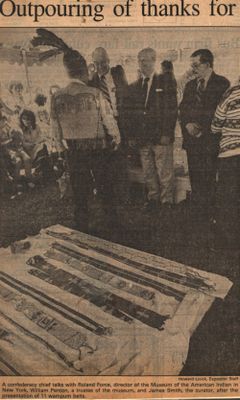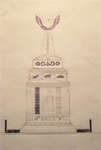"Outpouring of Thanks for Return of Wampum Belts"
- Full Text
- Outpouring of thanks for return of wampum belts
"Thanks"
The woman, a clan mother of the Six Nations Iroquois Confederacy, grasped Roland Forces hand, smiled shyly and said what everyone felt.
Mr. Force, director of the Museum of the American Indian, knew he had made the right choice.
Officials from the museum in New York City travelled to the Onondaga longhouse on the Six Nations Reserve to return II wampum belts stolen from the confederacy in 1893.
Many were so moved they could hardly speak. Made of small white and purple conch shells strung on animal sinew, __ _ __ back, the belts were used by the confederacy to record agreements with Britain and France in the 18th and 19th centuries.
The confederacy considers wampum a sacred medium given to it by the Creator. The belts are the confederacy's record of history.
"Our Creator never showed us how to write," said Robert Jamieson, translating Cayuga chief Jacob Thomas who spoke in his native language. "We were given wampums so our people know what transpired."
It would take two weeks to tell the stories of the belts, Mr. Thomas said.
The Two Row Wampum and the Covenant Chain are the two most significant belts. The first shows the promise of the confederacy and Britain not to interfere in each other's affairs. The second symbolizes their friendship.
The confederacy, called the Hodenushonnee or People of the Longhouse after the long buildings they lived in, is an organization of six nations - Mohawks, Cayugas, Onondagas, Oneidas, Senecas and Tuscaroras. Said to have been formed in 1570, it is the oldest league of nations in the world.
The solemn four-hour ceremony under a canopy at the back of the longhouse, considered the confederacy's capital in Canada, was the last chapter of a remarkable story about the search for the belts which began in 1893.
The belts disappeared when Onondaga chief John Buck, "keeper of the wampums," died that year.
Thomas Roddy, a man from Chicago who dealt native goods, bought the belts from Joshua Buck, the chief's son, in 1899.
Mr. Roddy sold them to another man, Willis Witte, who sold them to George Heye, who founded the Museum of the American Indian in 1922.
The Department of Indian Affairs was told in 1900 that the belts had been stolen and the government informed Mr. Roddy in a letter. Chief William Sandy asked the government about the belts in 1909 and the government was notified again in 1914. It wrote again to Mr. Roddy and then to Mr. Heye.
The confederacy council passed a resolution in 1915 confirming that the belts belong to it and naming six chiefs who could identify the belts.
Little was done and the government deposed the council for a new system in 1924. It would not address the matter again.
Mr. Heye, believed to have known that the belts were stolen, refused to return them unless the confederacy admitted that one of their members had stolen the belts. The confederacy didn't want to.
Fifty-three years later, Paul Williams, the confederacy's lawyer, wrote the Museum of the American Indian for Information about wampum belts. Mr. Williams, the chiefs and the museum began negotiating the return of the belts in 1985.
"The main issue was title," said William Fenton, chairman of the museum's collections committee and retired professor of anthropology at Yale University. Mr. Fenton has studied the Iroquois for more than a half century. "We though they (the confederacy) had a case."
Still, said curator James Smith, "I hate giving anything up. It hurts. "But on the other hand, it's remedying a longtime wrong."
It was the first time a museum has returned historically significant and valuable wampum belts to the confederacy.
The belts, insured for more than $1 million at the museum, were rolled in pure muslin, cushioned by tissue paper and placed in a plain bag worn over the shoulder of Mr. Force's wife, Maryanne.
"When you're carrying something valuable, it's better to carry it in an inconspicuous bag," explained Mrs. Force, who researches and writes for the museum.
"We didn't want attention called to the fact we were carrying them. One does have to be careful."
The belts, in good condition except for a few missing beads, were carefully unwrapped by Mr. Force, Tom Hill, curator of the Woodland Museum, and Sadie Buck, assistant curator. They worked on the ground under the canopy, surrounded by chiefs and clan mothers who stood or sat still and quiet, staring.
"It felt so good to have them back," said Cora Davis, a Cayuga clan mother.
After the ceremony, the rest of the people formed a long line and filed past the belts, staring at them with curiosity and awe.
After the ceremony, the rest of the people formed a long line and filed past the belts, staring at them with curiosity and awe.
After the ceremony the belts were to be taken to the Woodland Museum's storage room where there is a controlled environment to protect artifacts. They probably will be displayed there, making an important addition to the museum's collection, Mr. Hill said.
"It's a great honor. These are major artifacts of international significance. A lot of people would like to see them."
- Mystery Question
- Who is the author of this article?[Please answer by clicking on the Comments tab]
- Creator
- Livick, Howard, Photographer
- Media Type
- Newspaper
- Item Types
- Articles
- Clippings
- Description
- "The woman, a clan mother of the Six Nations Iroquois Confederacy, grasped Roland Force's land, smiled shyly and said what everyone felt."
- Subject(s)
- Personal Name(s)
- Force, Roland ; Penton, William ; Smith, James ; Jamieson, Robert ; Thomas, Jacob ; Buck, John ; Buck, Joshua ; Roddy, Thomas ; Witte, Willis ; Heye, George ; Sandy, William ; Williams, Paul ; Fenton, William ; Force, Maryanne ; Hill, Tom ; Buck, Sadie ; Davis, Cora.
- Corporate Name(s)
- Six Nations Iroquois Confederacy ; Haudenosaunee Confederacy Chiefs Council
- Local identifier
- SNPL002588v02d
- Collection
- Scrapbook #1 by Janet Heaslip
- Language of Item
- English
- Geographic Coverage
-
-
Ontario, Canada
Latitude: 43.06681 Longitude: -80.11635
-
- Creative Commons licence
 [more details]
[more details]- Copyright Statement
- Public domain: Copyright has expired according to Canadian law. No restrictions on use.
- Copyright Date
- 1988
- Copyright Holder
- Brantford Expositor
- Contact
- Six Nations Public LibraryEmail:info@snpl.ca
Website:
Agency street/mail address:1679 Chiefswood Rd
PO Box 149
Ohsweken, ON N0A 1M0
519-445-2954



